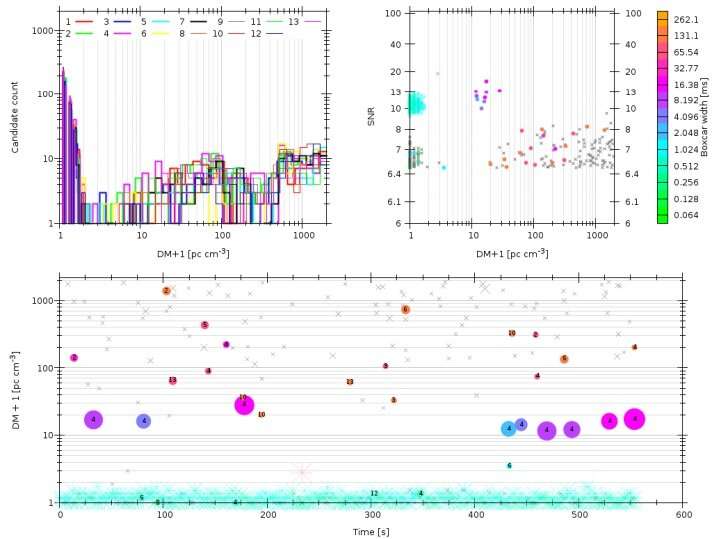October 17, 2019 report
SUPERB survey detects new slowly-spinning radio pulsar

Astronomers have detected a new slowly rotating radio pulsar as part of the SUrvey for Pulsars and Extragalactic Radio Bursts (SUPERB). The newly found object, designated PSR J2251−3711, turns out to be one of the slowest spinning radio pulsars known to date. The finding is detailed in a paper published October 9 on arXiv.org.
Extraterrestrial sources of radiation with a regular periodicity, known as pulsars, are usually detected in the form of short bursts of radio emission. Radio pulsars are generally described as highly magnetized, rapidly rotating neutron stars with a lighthouse beam of radiation that produces the pulsed emission.
However, finding new, long-period radio pulsars with a spin period of over 5.0 seconds is challenging. Notably, only five of the 10 longest-period pulsars known have been found in periodicity searches, mainly due to their consistently larger aggregated flux over time.
Now, a team of astronomers led by Vincent Morello of the University of Manchester, U.K., reports the discovery of a new radio pulsar with a very long spin period, which received designation PSR J2251-3711. The finding was made using the Parkes Observatory in Australia, as part of the SUPERB survey.
"At the time of discovery, SUPERB was using a Fourier-domain search as well as a single pulse search, and it was in the latter that the pulsar was first detected, in a nine-minute blind survey observation taken on December 8, 2015," the astronomers wrote in the paper.
The newfound pulsar has a spin period of approximately 12.12 seconds. This makes it the second slowest-spinning radio pulsar known to date. Currently, PSR J0250+5854, with a spin period of 23.5 seconds, is the slowest-spinning radio pulsar detected.
The authors of the study theorize that PSR J2251-3711 could be located some 1,600 or even 4,200 light years away, according to different estimates. These calculations are based on the dispersion measure of this pulsar, which was measured to be 12.12 parsecs/cm3.
The research found that it has a surface magnetic field of about 13 trillion G, characteristic age of 14.7 million years, and spin-down luminosity of approximately 290 octillion erg/s.
Taking into account the results, the astronomers consider two plausible evolution scenarios for PSR J2251-3711. The first one suggests that it would have been born with parameters similar to those of the Crab pulsar and have undergone a spin-down evolution dominated by magnetic dipole braking. The second one proposes that it started its neutron star life as a magnetar.
However, further observations of slow-spinning pulsars are needed to better understand the evolutionary pathways of PSR J2251-3711 and similar objects.
"It will be interesting in the near future to determine which evolutionary paths the emerging population of very slow radio pulsars (P > 10 s) actually followed. This should hopefully bring new constraints to magneto-thermal evolution models and overall contribute to a unified vision of the apparent neutron star diversity," the astronomers concluded.
More information: The SUrvey for Pulsars and Extragalactic Radio Bursts IV: Discovery and polarimetry of a 12.1-second radio pulsar, arXiv:1910.04124 [astro-ph.HE] arxiv.org/abs/1910.04124
© 2019 Science X Network





















